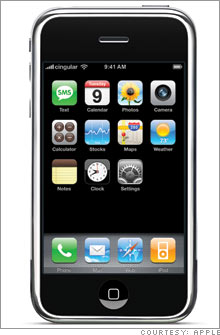Behind the iPhone musicStanley Sigman, CEO of AT&T's wireless operations, talks with Fortune's Stephanie Mehta about the decision not to sell the iPhone online, what he thinks about all the excitement, and more.(Fortune Magazine) -- Apple CEO Steve Jobs isn't the only executive girding himself for the iPhone's release June 29. Stanley Sigman, CEO of AT&T Mobility, has been getting his team ready for iPhone mania for months. Sigman, a wireless industry veteran who is credited with turning around Cingular (as AT&T's wireless unit was previously was known) five years ago, recently spoke with FORTUNE's Stephanie N. Mehta about his company's hot new device, AT&T's partnership with Apple (Charts, Fortune 500) -- and why the iPhone could be bigger than Caller ID. Here are excerpts from their conversation: Q. You've worked in the U.S. wireless industry since its inception. Has there been an event that has generated as much consumer excitement as the iPhone launch?  A. I've never before experienced the kind of excitement that we have around this device. We've had other milestones in the industry that, looking back on them, were significant milestones, like the StarTac phone from Motorola (Charts, Fortune 500), the first small analog phone. I think of the RAZR phone, I think of the excitement that's been around the (Samsung) BlackJack, but I've never enjoyed the consumer excitement that we've seen around the iPhone. Q. So it is bigger than the launch of Caller ID, which AT&T's predecessor company, SBC, got a huge percentage of its residential customers to buy. A. Caller ID wasn't a big thing. A long time after it was launched, 99.5% of the customers still didn't know what it was. It wasn't until we started pushing it and word-of-mouth started getting around that it started to take off. Obviously, we don't have that issue with the iPhone. It isn't something that's going to slowly take off. Q. How are you getting AT&T stores ready for June 29? A. We saw this as a real opportunity to accelerate our brand transition from Cingular to AT&T (AT&T (Charts, Fortune 500) is phasing out the Cingular brand). We've spent hundreds and hundreds of hours in training in preparation of this, and we've hired thousands of incremental summer hires to handle the load. Q. Are people going to be able to buy iPhones via the AT&T wireless website. Or is this a device they have to come into the stores to purchase? A. Initially it won't be on the AT&T website. It will be in our 2,200 stores, in the Apple stores and on the Apple website. Q. What was the thinking behind not putting it on the AT&T website immediately? A. We eventually want to put it on our website, but we thought it would be a better experience to come in and touch it, feel it. And it would also give us an opportunity to showcase all of our other products. Q. How do you feel about Apple's marketing of the iPhone: Some of the ads seem to suggest it is a multimedia player first and a communications device second. Does that chafe? A. The intent of the advertising is just to show the breadth of products that's on the device. First and foremost, it's the best iPod that Apple has ever put out. It's an iPod that allows you to load your library of music from your iTunes to your phone. It is a great phone with great contact lists. It is a great Web browser experience. Its Google Maps capabilities are phenomenal. And there's the Visual Voicemail we developed with Apple: It will be the first where you pick the order in which you retrieve voicemail. I hope the advertising is depicting that it is more than a phone. Q. What has AT&T influenced, if anything, on the iPhone: Where are your fingerprints on the device? A. It was approaching three years ago when I first received a call from Steve and he shared with me what his vision was. I had not seen a phone and Steve had not held a phone. He had a vision of the phone at that time, and this (contractually obligating AT&T to deploy the iPhone) was in some respects a difficult decision to make because it required me to make a commitment to a device that I had not tested. At the end of the day, I had confidence that Steve and his team had the capability to design hardware and develop software that would nail it, and I had confidence in our ability to work with them on the radio side and the technical side. We're not going to take credit for the concept, the hardware or the software. He did that. But we worked with them hand in hand in the testing process to make sure it was what he wanted it to be and what we wanted it to be. Watch for part two of the Mehta's interview with Sigman, in which he talks about how other phone makers are reacting to AT&T's deal with Apple, and how his personal 30-day trial of the iPhone is going. |
Sponsors
|
